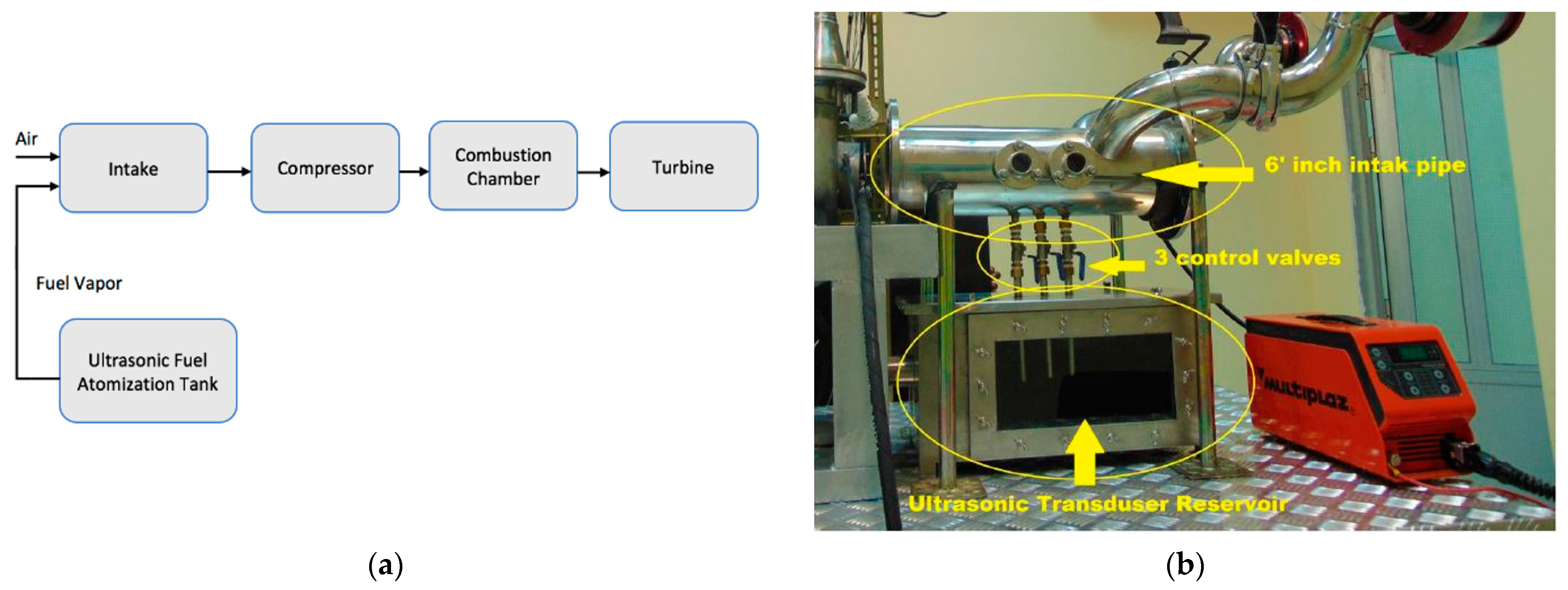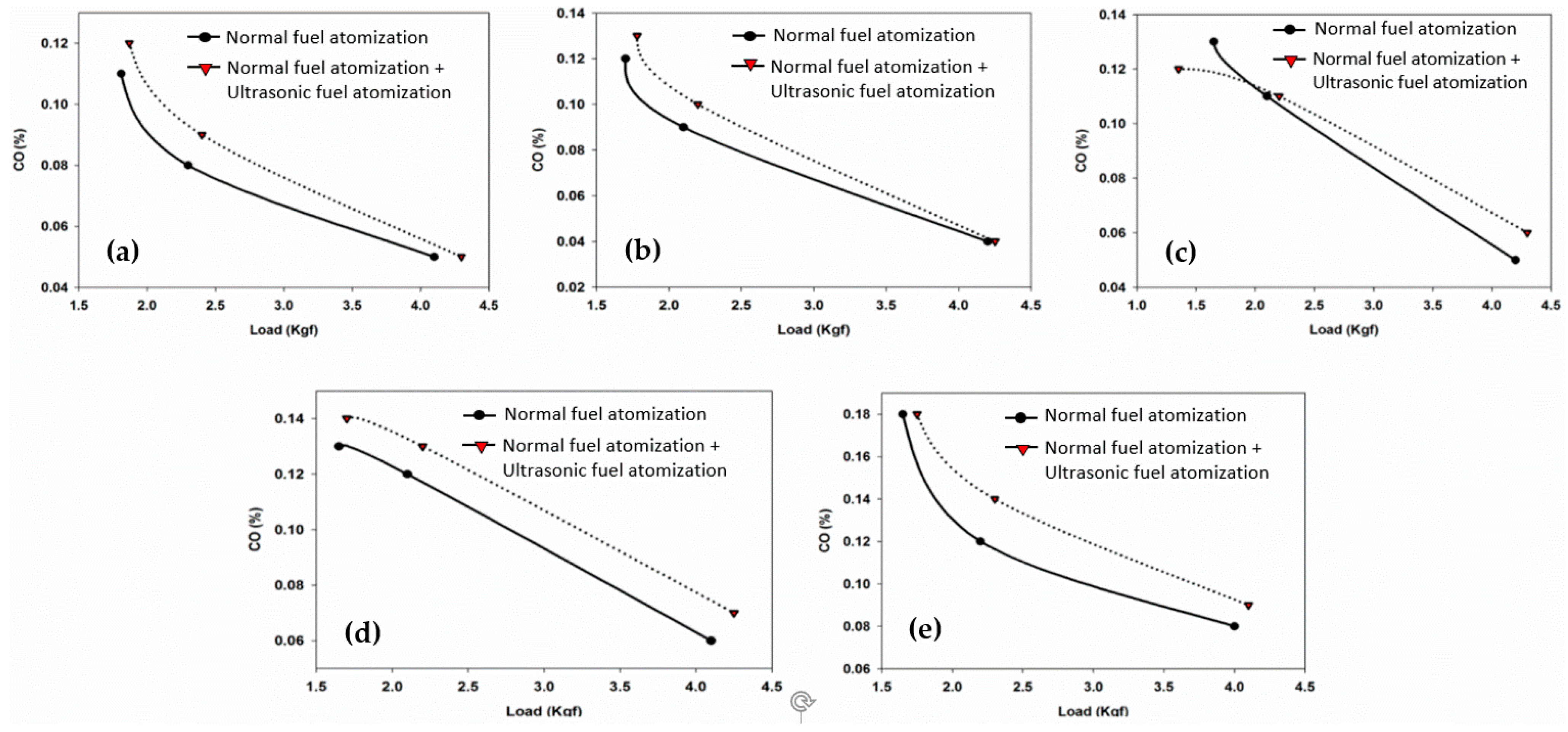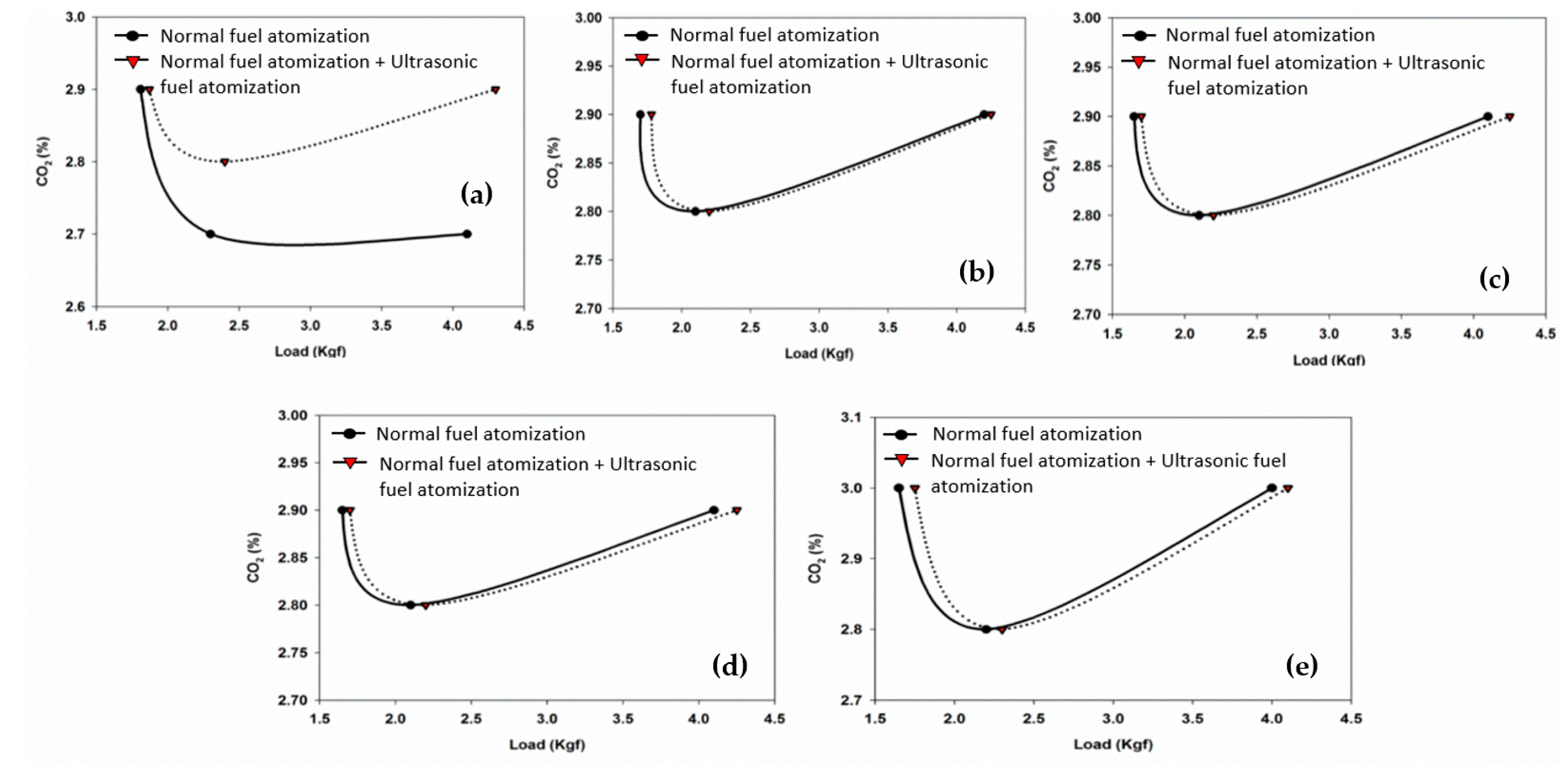Application of Ultrasonic Atomization on a Micro Jet Engine Using Biofuel for Improving Performance
Abstract
:1. Introduction
2. Materials and Methods
2.1. Internal Combustion Engine Lab
2.2. Micro Gas Turbine Setup
2.2.1. Gas Turbine Engine
2.2.2. Gas Turbine Engine and Systems
2.3. Ultrasonic Atomization System
2.4. Sensors
2.4.1. Thermocouples Sensor
2.4.2. Pressure Sensor
2.4.3. Mass Flow Sensor
2.4.4. Combustion Analyzer Device
2.4.5. Load Scale
2.4.6. Fuel Consumption
3. Results and Discussion
3.1. Standard Fuel Specification
3.2. Results of Engine Performance Analysis
3.2.1. Air-Flow Rate
3.2.2. Fuel Flow Rate
3.3. Emission Data Measurements
3.3.1. CO Emission
3.3.2. CO2 Emissions
3.3.3. NO Emissions
3.3.4. NO2 Emissions
4. Conclusions
Author Contributions
Funding
Data Availability Statement
Acknowledgments
Conflicts of Interest
References
- Abbasi, M.; Chahartaghi, M.; Hashemian, S.M. Energy, exergy, and economic evaluations of a CCHP system by using the internal combustion engines and gas turbine as prime movers. Energy Convers. Manag. 2018, 173, 359–374. [Google Scholar] [CrossRef]
- Máša, V.; Bobák, P.; Vondra, M. Potential of gas microturbines for integration in commercial laundries. Oper. Res. Int. J. 2017, 17, 849–866. [Google Scholar] [CrossRef]
- Badeer, G.H. GE Aeroderivative Gas Turbines—Design and Operating Features. GE Power Syst. 2000, GER-3695E, 1–20. [Google Scholar]
- Habib, Z.; Parthasarathy, R.; Gollahalli, S. Performance and emission characteristics of biofuel in a small-scale gas turbine engine. Appl. Energy 2010, 87, 1701–1709. [Google Scholar] [CrossRef]
- Tanbay, T.; Durmayaz, A. Exergy-based ecological optimisation of a turbofan engine. Int. J. Exergy 2015, 16, 358–381. [Google Scholar] [CrossRef]
- Domen, S.; Gotoda, H.; Kuriyama, T.; Okuno, Y.; Tachibana, S. Detection and prevention of blowout in a lean premixed gas turbine model combustor using the concept of dynamical system theory. Proc. Combust. Inst. 2015, 35, 3245–3253. [Google Scholar] [CrossRef] [Green Version]
- Jiang, G.; Zhang, Y.; Wen, H.; Xiao, G. Study of the generated density of cavitation inside diesel nozzle using different fuels and nozzles. Energy Convers. Manag. 2015, 103, 208–217. [Google Scholar] [CrossRef]
- Zahmatkesh, I.; Emdad, H.; Alishahi, M.M. Navier-Stokes computation of some gas mixture problemsin the slip flow regime. Sci. Iran. 2015, 22, 187–195. [Google Scholar]
- Roudini, M.; Wozniak, G. Experimental investigation of spray characteristics of pre-filming air-blast atomizers. J. Appl. Fluid Mech. 2018, 11, 1455–1469. [Google Scholar] [CrossRef]
- Khan, M.A.; Katoch, A.; Gadgil, H.; Kumar, S. First step towards atomization at ultra-low flow rates using conventional twin-fluid atomizer. Exp. Therm. Fluid Sci. 2019, 109, 109844. [Google Scholar] [CrossRef]
- Gemci, T.; Chigier, N. Production, Handling and Characterization of Particulate Materials; Merkus, H.G., Meesters, G.M.H., Eds.; Springer International Publishing: Cham, Switzerland, 2016; Volume 25, pp. 257–289. [Google Scholar]
- Ma, R.; Dong, B.; Yu, Z.; Zhang, T.; Wang, Y.; Li, W. An experimental study on the spray characteristics of the air-blast atomizer. Appl. Therm. Eng. 2014, 88, 149–156. [Google Scholar] [CrossRef]
- Chong, C.T.; Hochgreb, S. Flame structure, spectroscopy and emissions quantification of rapeseed biodiesel under model gas turbine conditions. Appl. Energy 2015, 185, 1383–1392. [Google Scholar] [CrossRef] [Green Version]
- Senda, J.; Wada, Y.; Kawano, D.; Fujimoto, H. Improvement of combustion and emissions in diesel engines by means of enhanced mixture formation based on flash boiling of mixed fuel. Int. J. Engine Res. 2008, 9, 15–27. [Google Scholar] [CrossRef]
- Lefebvre, A.H.; McDonell, V.G. Atomization and Sprays; CRC Press: Boca Raton, FL, USA, 2017. [Google Scholar]
- Park, S.H.; Cha, J.; Lee, C.S. Spray and engine performance characteristics of biodiesel and its blends with diesel and ethanol fuels. Combust. Sci. Technol. 2011, 183, 802–822. [Google Scholar] [CrossRef]
- Alajmi, F.; Alajmi, A.; Alrashidi, A.; Alrashidi, N.; Adam, N.M.; Hairuddin, A.A. Development of Solar Powered Biodiesel Reactor for Kuwait Sheep Tallow. Processes 2021, 9, 1623. [Google Scholar] [CrossRef]
- Gumus, M.; Sayin, C.; Canakci, M. The impact of fuel injection pressure on the exhaust emissions of a direct injection diesel engine fueled with biodiesel–diesel fuel blends. Fuel 2012, 95, 486–494. [Google Scholar] [CrossRef]
- Enweremadu, C.C.; Rutto, H.L. Combustion, emission and engine performance characteristics of used cooking oil biodiesel—A review. Renew. Sustain. Energy Rev. 2010, 14, 2863–2873. [Google Scholar] [CrossRef]
- Gumus, M. A comprehensive experimental investigation of combustion and heat release characteristics of a biodiesel (hazelnut kernel oil methyl ester) fueled direct injection compression ignition engine. Fuel 2010, 89, 2802–2814. [Google Scholar] [CrossRef]
- Palash, S.M.; Masjuki, H.H.; Kalam, M.A.; Atabani, A.E.; Fattah, I.R.; Sanjid, A. Biodiesel production, characterization, diesel engine performance, and emission characteristics of methyl esters from Aphanamixis polystachya oil of Bangladesh. Energy Convers. Manag. 2015, 91, 149–157. [Google Scholar] [CrossRef] [Green Version]







| Specifications | Values |
|---|---|
| Voltage | Input, AC 220 V; output, DC 48 V |
| Power | 250 W.L |
| Current | 5 A |
| Capacity | 4.5 kg/h |
| Frequency | 1.7 MHz |
| Operating temperature | 5 °C to 50 °C |
| Properties | Standards | Units | Diesel | Kerosene | B20 | B50 | B75 | B100 |
|---|---|---|---|---|---|---|---|---|
| Kinematic Viscosity @ 40 °C | ASTM D 445 | cSt | 3.5819 | 1.2144 | 1.5832 | 2.1677 | 2.1677 | 4.339 |
| Density @ 25 °C | ASTMD4052 | g/cm3 | 0.8339 | 0.7822 | 0.8006 | 0.8219 | 0.8576 | 0.8649 |
| Cloud point | ASTMD5773 | °C | 0 | −53.8 | −3.5 | 6.5 | 6.9 | 11.2 |
| Pour point | ASTMD5949 | °C | 0 | −54 | −12 | 0 | 6 | 15 |
| Flash point | ASTM D 93 | °C | 90 | 47 | Insufficient sample | 89 | 62 | 97 |
| Total acid number | ASTM D 664 | mgKOH/gm | 0.0110 | 0.0124 | 0.0321 | 0.0570 | 0.1778 | 0.1035 |
| Sulfur content | ASTMD5453 | mg/L | 620.17 | 92.17 | 73.98 | 55.02 | 30.07 | 9.06 |
| Water content | ASTMD6304 | ppm | 83.28 | 87.48 | 251.1 | 419.4 | 1340 | 790.2 |
| Method | Load | Fuel Types, L/s | ||||
|---|---|---|---|---|---|---|
| Kerosene | B20 | B50 | B75 | B100 | ||
| Normal fuel atomization | Low | 260.00 ± 1.55 | 260.10 ± 1.55 | 260.10 ± 1.55 | 260.10 ± 1.55 | 260.10 ± 1.55 |
| Medium | 397.80 ± 0.75 | 397.80 ± 0.70 | 397.80 ± 0.70 | 397.80 ± 0.70 | 397.80 ± 0.70 | |
| High | 515.10 ± 1.00 | 515.10 ± 1.00 | 515.10 ± 1.00 | 515.10 ± 1.00 | 515.10 ± 1.00 | |
| Normal fuel atomization + ultrasonic fuel atomization | Low | 263.20 ± 1.55 | 263.20 ± 1.55 | 263.20 ± 1.55 | 263.20 ± 1.55 | 263.20 ± 1.55 |
| Medium | 399.30 ± 0.75 | 399.10 ± 0.70 | 399.10 ± 0.70 | 399.10 ± 0.70 | 399.30 ± 0.70 | |
| High | 517.40 ± 1.00 | 517.40 ± 1.00 | 517.40 ± 1.00 | 517.40 ± 1.00 | 517.40 ± 1.00 | |
| Method | Load | Fuel Types, mL/min at 8 Bar | ||||
|---|---|---|---|---|---|---|
| Kerosene | B20 | B50 | B75 | B100 | ||
| Normal fuel atomization | Low | 360.00 ± 0.92 | 360.00 ± 0.92 | 360.00 ± 0.92 | 360.00 ± 0.92 | 360.00 ± 0.92 |
| Medium | 460.00 ± 1.22 | 460.00 ± 1.22 | 460.00 ± 1.22 | 460.00 ± 1.22 | 460.00 ± 1.22 | |
| High | 565.00 ± 1.60 | 565.00 ± 1.60 | 565.00 ± 1.60 | 565.00 ± 1.60 | 565.00 ± 1.60 | |
| Normal fuel atomization + ultrasonic fuel atomization | Low | 360.00 ± 0.92 | 360.00 ± 0.92 | 360.00 ± 0.92 | 360.00 ± 0.92 | 360.00 ± 0.92 |
| Medium | 460.00 ± 1.22 | 460.00 ± 1.22 | 460.00 ± 1.22 | 460.00 ± 1.22 | 460.00 ± 1.22 | |
| High | 565.00 ± 1.60 | 565.00 ± 1.60 | 565.00 ± 1.60 | 565.00 ± 1.60 | 565.00 ± 1.60 | |
Publisher’s Note: MDPI stays neutral with regard to jurisdictional claims in published maps and institutional affiliations. |
© 2021 by the authors. Licensee MDPI, Basel, Switzerland. This article is an open access article distributed under the terms and conditions of the Creative Commons Attribution (CC BY) license (https://creativecommons.org/licenses/by/4.0/).
Share and Cite
Alajmi, A.; Alajmi, F.; Alrashidi, A.; Alrashidi, N.; Adam, N.M. Application of Ultrasonic Atomization on a Micro Jet Engine Using Biofuel for Improving Performance. Processes 2021, 9, 1963. https://doi.org/10.3390/pr9111963
Alajmi A, Alajmi F, Alrashidi A, Alrashidi N, Adam NM. Application of Ultrasonic Atomization on a Micro Jet Engine Using Biofuel for Improving Performance. Processes. 2021; 9(11):1963. https://doi.org/10.3390/pr9111963
Chicago/Turabian StyleAlajmi, Amer, Fnyees Alajmi, Ahmed Alrashidi, Naser Alrashidi, and Nor Mariah Adam. 2021. "Application of Ultrasonic Atomization on a Micro Jet Engine Using Biofuel for Improving Performance" Processes 9, no. 11: 1963. https://doi.org/10.3390/pr9111963
APA StyleAlajmi, A., Alajmi, F., Alrashidi, A., Alrashidi, N., & Adam, N. M. (2021). Application of Ultrasonic Atomization on a Micro Jet Engine Using Biofuel for Improving Performance. Processes, 9(11), 1963. https://doi.org/10.3390/pr9111963





